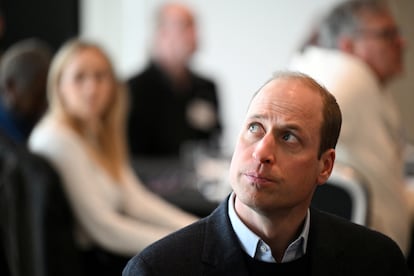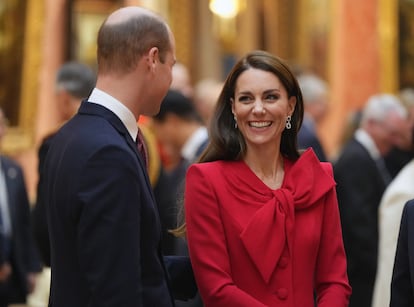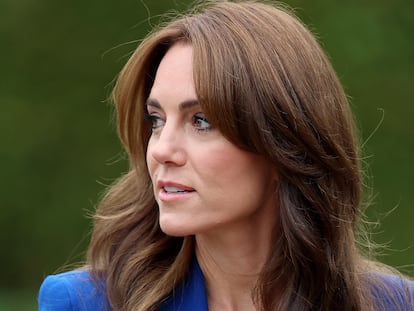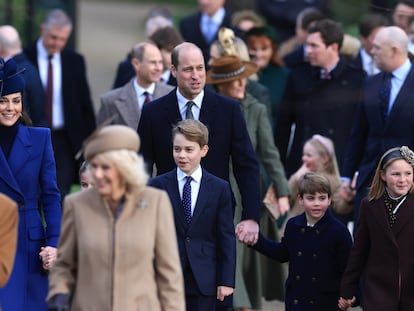Prince William, the grieving royal who has learned to suffer in silence
The heir to the throne understood from an early age that duty comes first: it is a mantra he made his own when he had to walk behind the coffin of his mother, Princess Diana. Now he has to deal with his father and wife’s cancer while taking care of three children and leading the monarchy

Prince William was 13 when his mother, Diana, Princess of Wales, admitted in a BBC interview that her husband, then Prince Charles, had been unfaithful to her with Camilla Parker Bowles — Britain’s current Queen — and that she herself had had an affair with her sons’ riding instructor, Captain James Hewitt. “There were three of us in my marriage,” the Princess confessed in November 1995 in front of an audience of 23 million Brits and 200 million worldwide. William had just begun at Eton, and followed the so-called “interview of the century” from his house master Andrew Gailey’s office.
When the broadcast ended, Gailey found him slumped on the couch, his eyes red from crying. But, said Gailey, the rince quickly pulled himself together and ran back to his room. Diana herself told her friend Simone Simmons that the following weekend William accused her of making a fool of herself and of him. He was inconsolable and raged at his mother, though he apologized the next day and gave her a small posy of flowers. All the same, Diana realized that she had caused him deep and irreparable harm.
Now, at 41, the British heir to the throne is someone capable of incredible emotional control, particularly in public. Royal experts agree that he learned this from his grandmother, the late Queen Elizabeth II, whose motto was “never complain, never explain.” He can smile when he is sad or appear calm in times of stress and tension. He has demonstrated this in recent weeks. While his wife, Catherine — or Kate Middleton, the current Princess of Wales — was recovering from abdominal surgery and beginning a course of preventative chemotherapy, as she explained on March 22, he was back at work looking calm. While the world joked about his wife’s absence and speculated about their marriage, he acted as though it was business as usual.
Princess Diana confessed to royal biographer Ingrid Seward that her eldest son was never comfortable with public exposure. In 1996, when the press published photos of his mother sunbathing topless in Spain, William called her to say the other Eton boys were teasing him. Diana told media executive Nicholas Coleridge that her son was being bullied, but that he was going to have to learn to deal with the teasing and gossip. The prince learned early on that duty came first: a mantra he painfully made his own when he had to walk behind his mother’s coffin at her funeral. He was 15 and didn’t want to do it, but his grandfather, Prince Philip, the late Duke of Edinburgh, convinced him that if he didn’t, he might regret it for the rest of his days. He hated every second of the long funeral procession, but disguised his feelings by walking with his eyes to the ground.

Princess Diana always defined her eldest son as a serious person, one who is distrustful of strangers and easily hurt. “William is the sensitive one,” the Princess would tell her friends. “But I’m sure he’ll deal with his problems. He will have to.” She also described him as being “intellectual,” but “very aware of people and their feelings.” That strength and empathy will be indispensable in the coming months.
Catherine alluded to her husband’s unwavering support in the video she posted on March 22. “In January, I underwent major abdominal surgery in London and at the time it was thought that my condition was non-cancerous,” she says to the camera. “The surgery was successful. However, tests after the operation found cancer had been present. My medical team therefore advised that I should undergo a course of preventative chemotherapy and I am now in the early stages of that treatment. This, of course, came as a huge shock, and William and I have been doing everything we can to process and manage this privately for the sake of our young family… Having William by my side is a great source of comfort and reassurance,” she added.
In the past, Prince William has been able to turn some of his traumas into causes. In 2021, an independent investigation concluded that journalist Martin Bashir had used forged documents to get close to Princess Diana and convince her to give the 1995 Panorama interview that so upset him. Following the ruling, the Prince said, “That interview has no legitimacy and should never be broadcast again.” He is a fervent defender of the right to privacy and very critical of questionable journalistic practices. When a French magazine published photos of Catherine sunbathing topless in Provence, he supported her in suing the weekly. In 2017, they won the lawsuit and received €190,000 in damages. In a letter he wrote for the case, he stated that the publication of those images was “particularly shocking” to him because it reminded him of the harassment that had led to the death of his mother. He also leads campaigns to flag up mental health issues and bullying. On more than one occasion, he has stated that bullying is no longer limited to schools and that new technology leaves us all more vulnerable to it.
In recent weeks, the Prince and Princess of Wales have been the target of online hoaxes and taunts. The coming months will not be easy. The Prince will have to deal with the illness of both his father, King Charles, as well as his wife, while taking care of three young children and leading the monarchy. And he will have to do so in the public gaze as well as under media and social media scrutiny.

The pressure will be considerable. But, as The Guardian journalist Harriet Sherwood explains, he will be able to focus on his family and take all the time he needs “without financial worries or fear of losing his job. Many spouses or partners in a similar position have to make hard choices.” Sherwood quotes the Macmillan Cancer Support charity saying, “Balancing working and caring” for someone with cancer “can be difficult.” It advises trying to find a “balance between the support you want to give and what you are able to do,” and talking to employers about possible flexible working arrangements.
As Sherwood pointed out, “Many people depend on the support — practical and emotional — of close relatives. Not for the first time, William may be reflecting on the breakdown in the once close relationship with his brother Harry, now living thousands of miles away and largely estranged from his family. While many families pull together in a crisis, and strengthen mutual bonds, this seems unlikely for the royals.”
However, Prince Harry seemed to suggest otherwise in a television interview last February after a quick visit to see his father in London. When he was asked if he thought it possible an illness in the family could bring them together, he replied, “I see it on a day-to-day basis, the strength of the family unit coming together. So, yes, I think any illness brings families together.”
But, for now, Prince William is coping largely alone. He knows there is no alternative because in the House of Windsor duty comes first. As his mother said, “I’m sure he’ll deal with his problems. He will have to.”
Sign up for our weekly newsletter to get more English-language news coverage from EL PAÍS USA Edition
Tu suscripción se está usando en otro dispositivo
¿Quieres añadir otro usuario a tu suscripción?
Si continúas leyendo en este dispositivo, no se podrá leer en el otro.
FlechaTu suscripción se está usando en otro dispositivo y solo puedes acceder a EL PAÍS desde un dispositivo a la vez.
Si quieres compartir tu cuenta, cambia tu suscripción a la modalidad Premium, así podrás añadir otro usuario. Cada uno accederá con su propia cuenta de email, lo que os permitirá personalizar vuestra experiencia en EL PAÍS.
¿Tienes una suscripción de empresa? Accede aquí para contratar más cuentas.
En el caso de no saber quién está usando tu cuenta, te recomendamos cambiar tu contraseña aquí.
Si decides continuar compartiendo tu cuenta, este mensaje se mostrará en tu dispositivo y en el de la otra persona que está usando tu cuenta de forma indefinida, afectando a tu experiencia de lectura. Puedes consultar aquí los términos y condiciones de la suscripción digital.
More information
Archived In
Últimas noticias
‘Sleepless City’: The light of cinema illuminates Madrid’s Cañada Real shantytown
All the effects of gentrification in one corner of Mexico’s Colonia Roma
Palestinian reporter Youmna El Sayed: ‘My family told me I had to choose between being a journalist or a mother’
The new language of the workplace: Knowing how to ask AI questions is more important than using it
Most viewed
- Families demand repatriation of bodies of Colombians who died in Ukraine: ‘This war is a slaughterhouse for foreigners’
- The low-cost creative revolution: How technology is making art accessible to everyone
- Liset Menéndez de la Prida, neuroscientist: ‘It’s not normal to constantly seek pleasure; it’s important to be bored, to be calm’
- Christian Louboutin: ‘Young people don’t want to be like their parents. And if their parents wear sneakers, they’re going to look for something else’
- ‘El Limones’ and the growing union disguise of Mexican organized crime











































